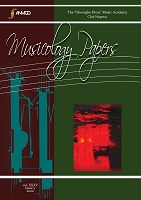“Ce este vocativul?” – György Kurtág and Romanian Folk Music
“Ce este vocativul?” – György Kurtág and Romanian Folk Music
Author(s): Bálint HorváthSubject(s): Music, Cultural Anthropology / Ethnology
Published by: MediaMusica
Keywords: Banat; biography; Bartók; berceuse; colinda; folk music; games; memories; mythology;
Summary/Abstract: The Banat, György Kurtág’s birthplace, is a multicultural region, home of several ethnic groups, but with a predominantly Romanian majority already in the first decades of the 20th century. Love for the Romanian language and culture (including folk music) has been constantly present in Kurtág’s life. Nevertheless, the initial childhood experiences appear relatively late in his oeuvre, during the 1970s, in the Játékok [Games] series. Kurtág’s relation to Romanian folk music is marked by pieces such as Hommage à Farkas Ferenc 2 – foszlányok egy kolinda emlékképéből [Scraps of a Colinda Melody – Faintly Recollected] and Doina from the Játékok series, the not yet published ...c’astăzi s’a născut... – Márta 90 éves! [...c’astăzi s’a născut… – Márta is 90 Years Old!] or the violin duet Triptic (Op. 45). The most grandiose work in this respect is the Colindă-Baladă (Op. 46), a monumental piece for choir and ensemble. Although Romanian folk music is not of central significance in Kurtág’s oeuvre, there are certainly several works inspired by Romanian folk music that play an important role in the development of his life-work. This paper aims to examine these works, and also mentions compositions which contain more indirect references.
Journal: Lucrări de Muzicologie
- Issue Year: 35/2020
- Issue No: 2
- Page Range: 7-23
- Page Count: 17
- Language: English
- Content File-PDF

